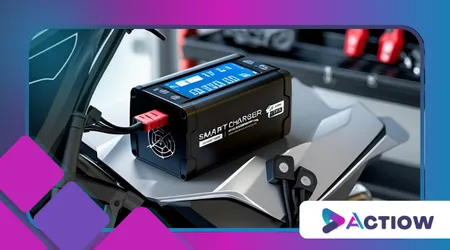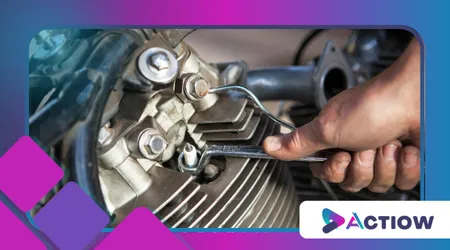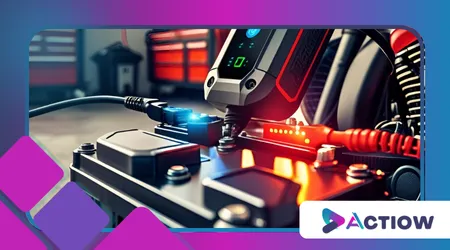Motorcycle Battery Maintenance in the Era of Smart Chargers
Anúncios
Motorcycle battery maintenance has evolved dramatically with the advent of smart chargers, transforming a once tedious task into a streamlined, technology-driven process.
Riders today face a landscape where precision and efficiency reign, yet many still cling to outdated practices that risk shortening battery life.
Consequently, understanding how to leverage smart chargers alongside traditional maintenance techniques is crucial for ensuring peak performance and longevity.
Motorcycle battery maintenance

Anúncios
This article explores the nuances of motorcycle battery maintenance, weaving in practical insights, innovative approaches, and the undeniable advantages of modern charging technology.
Why should riders care about battery maintenance in this era?
++ Why You Should Check Your Cabin Air Filter More Often in 2025
A well-maintained battery not only ensures reliable starts but also enhances the overall riding experience. Neglecting it, however, can lead to frustrating breakdowns or costly replacements.
With smart chargers, the process becomes less about guesswork and more about precision, but riders must still master the fundamentals to maximize their investment.
This guide will unpack the essentials, debunk myths, and provide actionable strategies to keep your motorcycle battery in top shape.
By blending time-tested methods with cutting-edge technology, riders can unlock the full potential of their batteries.
From understanding battery chemistry to integrating smart chargers into daily routines, this article offers a comprehensive roadmap.
Additionally, we’ll address common questions, share real-world examples, and provide data-driven insights to empower riders.
Let’s dive into the world of motorcycle battery maintenance and discover how smart chargers are revolutionizing the game.
Understanding Motorcycle Battery Chemistry

Motorcycle batteries, whether lead-acid, AGM (Absorbent Glass Mat), or lithium-ion, operate on distinct chemical principles that dictate their maintenance needs.
Lead-acid batteries, for instance, rely on a sulfuric acid electrolyte interacting with lead plates, producing energy through a chemical reaction.
++ Should You Still Warm Up Your Car in 2025? Experts Weigh In
Meanwhile, lithium-ion batteries use lithium compounds to store and release energy, offering lighter weight and higher efficiency.
Understanding these differences is critical because each type demands specific care to avoid damage and ensure longevity.
For example, overcharging a lead-acid battery can cause sulfation, where lead sulfate crystals build up on the plates, reducing capacity.
Conversely, lithium-ion batteries require precise voltage regulation to prevent overheating or capacity degradation.
Smart chargers address these challenges by automatically adjusting the charging rate based on the battery’s chemistry and condition.
Consequently, riders must select a charger compatible with their battery type, as mismatched equipment can lead to inefficiencies or even permanent damage.
Consider a rider, Alex, who owns a classic cruiser with a lead-acid battery.
He initially used a generic charger, unaware of its fixed output, which overcharged his battery and reduced its lifespan by 30%.
After switching to a smart charger with a lead-acid mode, Alex noticed improved starting power and extended battery life.
This example underscores the importance of aligning maintenance practices with battery chemistry, a principle that smart chargers simplify through automation.
The Role of Smart Chargers in Modern Maintenance

Smart chargers have redefined motorcycle battery maintenance by introducing automation and precision to a historically manual process.
Unlike traditional chargers, which deliver a constant current regardless of the battery’s state, smart chargers use microprocessors to monitor voltage, temperature, and charge levels.
As a result, they deliver tailored charging cycles that prevent overcharging, undercharging, or overheating, extending battery life significantly.
A 2023 study by the Motorcycle Industry Council found that 68% of riders using smart chargers reported fewer battery-related issues compared to those using conventional chargers.
This statistic highlights the tangible benefits of adopting smart technology.
These devices often feature multi-stage charging—bulk, absorption, and float phases—that optimize energy delivery.
Furthermore, many include desulfation modes to reverse minor sulfation in lead-acid batteries, effectively reviving underperforming units.
Imagine your motorcycle battery as a marathon runner: a traditional charger is like a coach who pushes the runner at full speed regardless of fatigue, risking burnout.
A smart charger, however, adjusts the pace, providing bursts of energy when needed and rest when appropriate.
This analogy illustrates why smart chargers are game-changers they adapt to the battery’s needs, ensuring optimal performance without unnecessary strain.
Practical Maintenance Tips for Riders
Maintaining a motorcycle battery goes beyond plugging it into a smart charger.
Regular inspection is a cornerstone of effective care, as corrosion on terminals or loose connections can impede performance.
Riders should clean terminals with a wire brush and apply dielectric grease to prevent oxidation.
Additionally, checking electrolyte levels in lead-acid batteries (if applicable) and ensuring proper storage during off-seasons are vital steps to avoid premature failure.
Temperature plays a pivotal role in battery health.
Extreme heat accelerates chemical reactions, causing faster degradation, while cold temperatures reduce capacity.
For instance, storing a battery in a garage that dips below freezing can cut its charge retention by up to 20%.
To counter this, riders should store batteries in temperature-controlled environments or use smart chargers with temperature compensation features, which adjust output based on ambient conditions.
Take Sarah, a touring enthusiast who rides year-round.
She neglected to check her battery’s terminals during a winter trip, leading to corrosion that caused a mid-ride failure.
After adopting a routine of monthly inspections and using a smart charger with a maintenance mode, Sarah’s battery remained reliable even in harsh conditions.
This example highlights how combining proactive maintenance with smart technology creates a robust strategy for battery care.
Common Myths and Misconceptions
Many riders fall prey to myths that undermine effective motorcycle battery maintenance.
One pervasive belief is that all batteries can be charged the same way, ignoring the unique needs of lead-acid, AGM, and lithium-ion types.
This misconception often leads to improper charging, reducing battery lifespan.
Smart chargers mitigate this by offering customizable settings, but riders must still understand their battery’s requirements to select the correct mode.
Another myth is that batteries don’t need maintenance if the motorcycle is ridden regularly. While frequent use helps, it doesn’t eliminate the need for periodic checks.
Vibration from riding can loosen connections, and short trips may not fully recharge the battery, especially in stop-and-go traffic.
Smart chargers with trickle modes can maintain optimal charge levels, but riders must complement this with visual inspections and proper storage practices.
Why do so many riders overlook these simple truths?
Misinformation and outdated advice often cloud judgment, leading to preventable issues.
By debunking these myths and embracing smart chargers, riders can shift from reactive fixes to proactive care, ensuring their batteries perform reliably for years.
Integrating Smart Chargers into Your Routine
Incorporating smart chargers into daily maintenance is straightforward but requires strategic planning.
Riders should charge their batteries after every ride, especially if the trip is short, to prevent deep discharge cycles that strain the battery.
Smart chargers make this effortless by automatically switching to maintenance mode once the battery is fully charged, eliminating the risk of overcharging.
Seasonal riders face unique challenges, as batteries left idle for months can self-discharge and develop sulfation.
Using a smart charger with a float mode during storage keeps the battery at an optimal charge level without manual intervention.
Additionally, riders should invest in chargers with diagnostic features, such as voltage testing or fault detection, to catch issues early and avoid costly replacements.
| Feature | Benefit | Best For |
|---|---|---|
| Multi-Stage Charging | Optimizes charge delivery, prevents overcharging | All battery types |
| Desulfation Mode | Reverses sulfation in lead-acid batteries, extending lifespan | Lead-acid and AGM batteries |
| Temperature Compensation | Adjusts charging based on ambient temperature, protecting battery health | Riders in extreme climates |
| Maintenance/Float Mode | Maintains charge during long-term storage, preventing self-discharge | Seasonal riders |
This table outlines key smart charger features and their practical applications, helping riders choose the right device for their needs.
By integrating these tools into their routines, riders can streamline maintenance and focus on the road ahead.
Frequently Asked Questions: Motorcycle battery maintenance
| Question | Answer |
|---|---|
| How often should I charge my battery? | Charge after every ride, especially short trips, to prevent deep discharge. Use a smart charger with maintenance mode for long-term storage. |
| Can I use a car charger for my motorcycle? | Avoid car chargers, as they often deliver excessive current, damaging motorcycle batteries. Opt for a smart charger designed for motorcycles. |
| How long do motorcycle batteries last? | Lead-acid batteries last 2–5 years, AGM 3–7 years, and lithium-ion up to 10 years with proper maintenance and smart charging. |
| What happens if I overcharge my battery? | Overcharging can cause sulfation in lead-acid batteries or overheating in lithium-ion, reducing lifespan. Smart chargers prevent this with automatic cutoffs. |
| Do I need to remove the battery to charge? | Not always, but disconnecting ensures safety and prevents electrical issues. Follow your charger’s instructions for in-situ charging. |
These questions address common concerns, providing clear, actionable answers to guide riders in their maintenance journey.
Smart chargers simplify many of these processes, but understanding the underlying principles remains essential.
Motorcycle battery maintenance: Conclusion
Motorcycle battery maintenance in the era of smart chargers is a blend of tradition and innovation.
By understanding battery chemistry, leveraging smart charger technology, and adopting proactive maintenance habits, riders can ensure reliable performance and extend battery life.
The shift from manual, error-prone charging to automated, precise systems marks a significant leap forward, yet it demands rider engagement to fully realize its benefits.
The examples of Alex and Sarah illustrate how small changes switching to a smart charger or establishing a maintenance routine can yield substantial results.
With 68% of riders reporting fewer issues thanks to smart chargers, the data supports this evolution.
As technology continues to advance, riders who embrace these tools will stay ahead of the curve, enjoying worry-free rides and longer-lasting batteries.
Ultimately, the question isn’t whether you can afford to invest in proper motorcycle battery maintenance it’s whether you can afford not to.
By integrating smart chargers and informed practices, riders can transform a mundane task into a strategic advantage, ensuring their motorcycles are always ready to hit the road.
